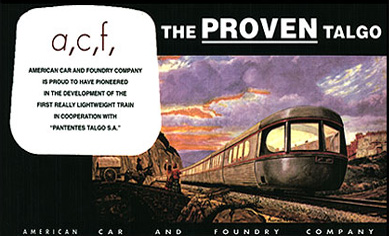History : Talgo North America
American Car and Foundry's Spanish Talgo Train was one of the first of the postwar extreme lightweight streamliners. The Talgo set a standard for all other manufacturers as the race for new development began in the 1950s. The radical design concepts of the Talgo gave hope to the American railroads that wanted to reverse the diminishing number of passengers.
It all began in 1944 when the American Car and Foundry (ACF) expanded on the Talgo concept in a joint effort to create the prototype trains for the Spanish National Railway. The units were manufactured at ACF's in Wilmington, Delaware.
 In 1949, American Car and Foundry announced its "revolution on rails." During a time when railroads felt a change in car design was needed, American Car and Foundry looked to Talgo for the answer. In 1950, three Talgo II locomotives and 32 railcars arrived in Spain, built at the American Car and Foundry in the United States.
In 1949, American Car and Foundry announced its "revolution on rails." During a time when railroads felt a change in car design was needed, American Car and Foundry looked to Talgo for the answer. In 1950, three Talgo II locomotives and 32 railcars arrived in Spain, built at the American Car and Foundry in the United States.
A Talgo demonstration in New Haven, Connecticut, was scheduled in 1954 and the first press run of the Talgo took place June 29th. In its spare time, when not completing press runs or demonstrations, the Talgo was placed on display at major passenger stations to prompt ridership.
Talgo history in the US continued in 1988 when Amtrak conducted test runs with Talgo tilting cars in order to establish the performance of high cant deficiency operation in the North East Corridor. This test clearly found that the Talgo natural tilt technology was superior to all other equipment tested at that time. The Talgo Train was judged to be the perfect match for the Boston to New York segment of the route due to its many sharp curves.
Talgo's presence in the United States broadened in 1994. In April, Renfe-Talgo of America was awarded a contract by the Washington State Department of Transportation (WSDOT) for a leased Talgo train set for operation in the Seattle, WA to Portland, OR corridor for six months.
In October of 1994, showcase runs of Talgo rolling stock were performed for railway authorities and technical experts in Oregon, California, Missouri, Ohio, Pennsylvania, Massachusetts, Connecticut and Maine. The contract with WSDOT was also renewed to continue the lease of the Talgo TP 200 trainset in the Pacific Northwest corridor.
As the project proved to be very successful, in July of 1996, WSDOT and Amtrak placed an order to buy three new Talgo TPU™ trains (two WSDOT and one Amtrak) and to lease one additional train (Amtrak). They were assembled in Seattle using American workers and skills. The new Talgo's started service in February 1998 and continue to be operated by Amtrak under the Amtrak Cascades® brand name.
A fifth train set was manufactured at the same time as the four previously mentioned. This train set was scheduled to enter service between Los Angeles, CA and Las Vegas, NV in early 2001, but was sold to WSDOT in 2003 and is currently in use ion the Eugene, Oregon to Vancouver, BC (Canada) Ccorridor.
So far, the operation of these trainsets has been a tremendous success; ridership has grown by more than 150%, travelling times have been significantly reduced, and the entire corridor has been revitalized. Furthermore, Amtrak Cascades® North (service between Seattle, WA and Vancouver, BC) and Amtrak Cascades® South (service between Seattle, WA and Portland and Eugene, OR) were ranked numbers 1 and 2 in 1999, according to Amtrak's National Customer Satisfaction Survey.
The success of the Pacific Northwest Project is the result of a good partnership experience among Talgo, Amtrak, WSDOT and Burlington Northern Santa Fe (the owner of the track). From the Talgo side, the key for success has been the design of the trains, including the many amenities available, such a individual electric outlets for laptops, wheelchair lifts on ADA cars, individual audio-video outlets; the quality of the ride and the great reliability that is assured by the application of Talgo's Total Logistic Care™, an integral maintenance system.
Talgo's preventative maintenance program that benefits from over fifty years of Talgo Group experience maintaining railway vehicles. In the United States, Talgo provides technical assistance and management services to Amtrak's personnel in charge of maintenance operations. Talgo is fully responsible for assuring reliability and availability ratios. Since the service started in 1994, Talgo has been able to maintain both reliability and availability in excess of 99%.

 Talgo Inc. US Corporate Office
Talgo Inc. US Corporate Office